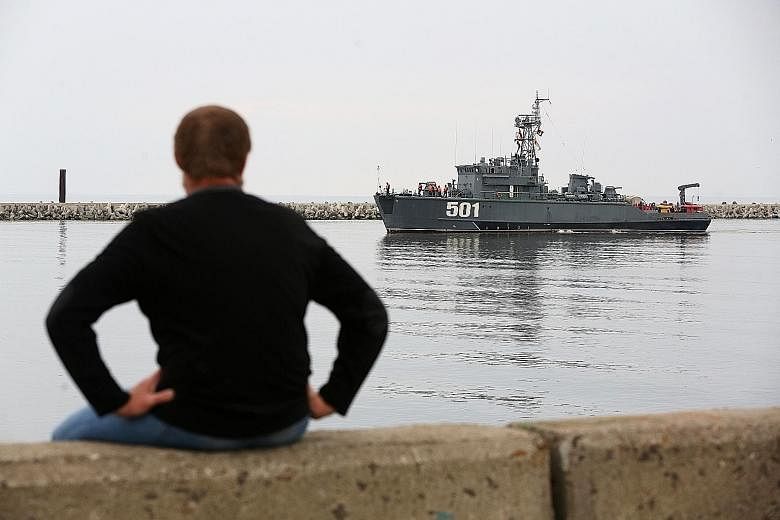MOSCOW • Mr Vadim Kuznetsov says that his excursion-boat business along Russia's border with Poland has been torpedoed by a new Cold War.
"They are scared," he said of the Poles, once his main customers who now no longer venture across the border for fishing trips. "What have they got to be afraid of?"
Some of the explanation is anchored just a few hundred metres away at the main base for Russia's Baltic Fleet. A minesweeper and a guided-missile cruiser give a hint of the biggest Russian military build-up in the region since communism collapsed.
An enclave wedged between Poland and Lithuania, Kaliningrad is increasingly returning to its Soviet- era role as a garrison on the strategic Baltic Sea coast amid Russia's recent rearmament.
This time, however, the countries just to the east - the Baltic states of Lithuania, Latvia and Estonia - are members of the North Atlantic Treaty Organisation (Nato), not part of the Soviet Union. How to protect them, which was a largely hypothetical question for the alliance until Russia's 2014 annexation of Ukraine's Crimea, has now become a central challenge for Nato.

Their location, all but cut off from the rest of the alliance by Kaliningrad, has turned them into an oversized version of West Berlin, which had to rely on Western airlifts during a Soviet blockade in 1948-49.
Largely surrounded by Russia, the Baltics are too exposed to defend effectively but too important for the alliance not to protect.
"Nato could not have militarily prevented a determined Soviet effort to overrun West Berlin, nor can it militarily prevent a determined Russian effort to overrun the Baltic states. But if the Soviets had overrun West Berlin, that would have meant war with Nato," said Mr Thomas Graham, a senior White House aide at the time the three Baltic countries joined the alliance more than a decade ago.
"In theory, the same thing should hold true if the Russians made an effort to overrun any Baltic state."
To help dispel doubts about its commitment, Nato will approve plans this week to deploy four battalions to rotate through the region.
But though bigger than what the military bloc has ever placed there before, the units will still be dwarfed by Russia's forces on the other side of the border.
The Kremlin argues that it is responding to Nato encroachment towards Russian borders. In May, Russia announced plans to put two new divisions in the western region, and another in the south. That could be about 30,000 troops, compared to 4,000 in Nato's plan.
Countries such as Sweden and Finland that remained neutral through the Cold War are now considering joining Nato.
"In the Baltic states - and elsewhere - Russia is feared," Finnish President Sauli Niinistoe said last week after meeting Russian President Vladimir Putin.
The Russian leader responded that Nato's build-up was a risk to his country's security. "All this creates an obvious threat for us that no one wants to notice," he said.
Even short of a full-scale attack, uncertainties about Nato's ability to defend its members have cast a shadow across the entire region.
"What the Russians would like to do politically is to undermine the confidence the Baltic states have in Nato's Article Five guarantee," said Mr Steven Pifer, who served as a United States deputy assistant of state from 2001 to 2004, referring to the treaty provision on mutual defence.
Some analysts say the Kremlin has succeeded in creating a climate of insecurity without actually needing to fight. Mr Putin "wants to divide Europe, divide Nato, and he has got a multitude of policies that he keeps pursuing to achieve those ends", said Mr Michael McFaul, a former US ambassador to Russia.
Finnish President Niinistoe warned last week that major additional Nato deployments could provoke a further Russian build-up as the Kremlin seeks to protect St Petersburg. "It's a vicious circle," he said. BLOOMBERG

